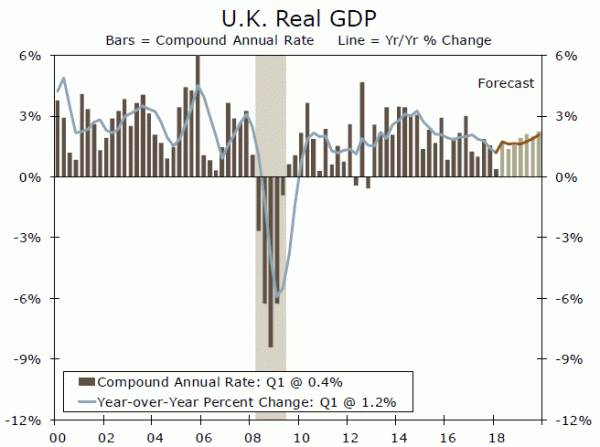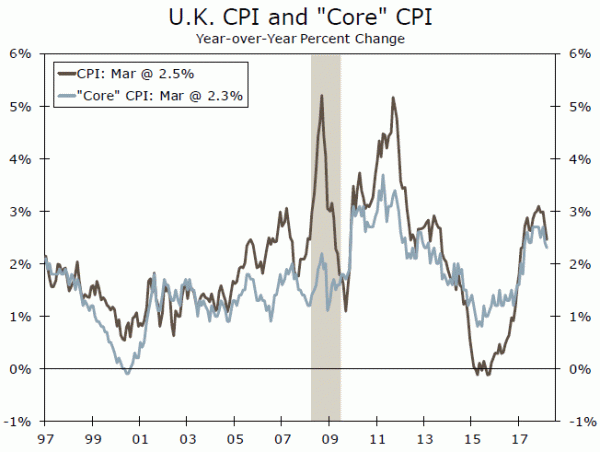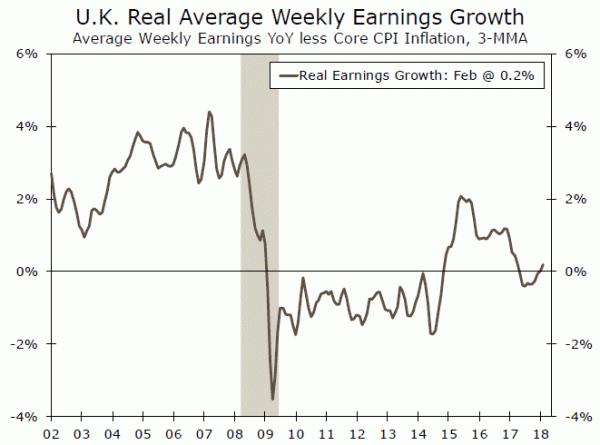GDP in the United Kingdom grew just 0.1 percent in Q1, with today’s print significantly weaker than consensus expectations. While growth should eventually pick up, we now look for the BoE to remain on hold until August.
Q1 GDP Growth Significantly Weaker Than Expected
Preliminary data released today showed that real GDP in the U.K. grew just 0.1 percent in Q1 (0.4 percent on an annualized basis) relative to the previous quarter (top chart). Today’s print was significantly weaker than expected, with the consensus expecting a 0.3 percent increase. Although details on underlying demand components are not available at this time, monthly indicators point to the mixed nature of the U.K.’s economic expansion in the aftermath of the Brexit Referendum in 2016. While some of the Q1 weakness may be due to bad winter weather, the slower overall pace of growth raises questions about the underlying health of the British economy.
Production Drives Growth, Yet Consumer Spending Likely Weak Data included in today’s release showed that industrial production rose 0.7 percent in Q1, driven by surging output in the mining sector, up 3.5 percent. Although overall industrial production was largely positive in Q1, output in the construction sector dropped sharply, down 3.3 percent.
While industrial production was a bright spot, the demand side of the equation was likely more mixed. The services sector expanded only 0.3 percent in Q1, and as most services are consumed domestically, the pace of consumer spending growth likely remained slow. Consumer spending, as measured by real retail sales, remains lackluster even as the labor market has tightened. Monthly real retail sales growth averaged just 1.5 percent year over year in Q1, compared to 2.6 percent in Q1-2017 and 4.1 percent in Q1-2016. At the same time, the unemployment rate hit a 42-year low of 4.2 percent in March, and nominal wage growth has also picked up, with average weekly earnings up 2.8 percent in February, year over year.
Slower growth in consumer spending likely stems from slower real wage growth even as nominal wages have increased. Real wage growth stagnated in the wake of Brexit as sterling depreciated sharply and drove consumer price inflation above 3 percent by mid-2017. But, inflation fell to 2.5 percent year over year in March (middle chart), and real wages are beginning to show signs of recovering (bottom chart). We look for inflation to continue to recede, which should lift growth in real income and consumer spending.
BoE Likely to Adopt A “Wait and See” Approach
In light of today’s weaker-than-expected GDP print, we now look for the Bank of England (BoE) to remain on hold until August, rather than hiking rates at its May 10 meeting. The BoE will likely adopt a “wait and see” approach to examine incoming economic data in the coming months before tightening policy. We look for economic growth to eventually pick up as inflation continues to recede and real wage growth recovers. Stronger growth in the coming quarters should support further rate hikes from the BoE, albeit at a gradual pace.















